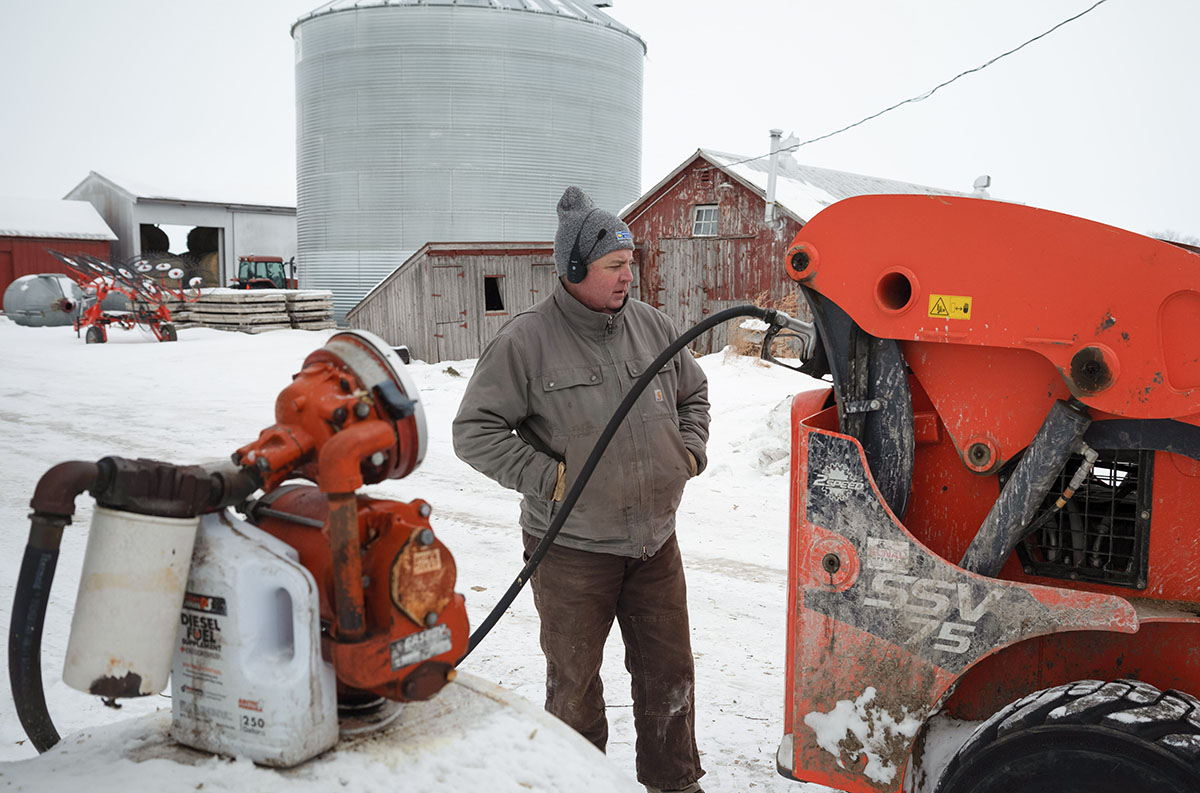
Dave Walton fuels up before doing chores on his farm near Wilton (Photo: Iowa Soybean Association)
Five tips to improve winter biodiesel performance
January 18, 2022 | Bethany Baratta
Dave Walton relies on biodiesel to power his tractors and machinery year-round. The farmer from Wilton likes biodiesel because of its dependability and increased lubricity. It’s also a homegrown product, made primarily from soybeans like those grown on his eastern Iowa farm.
About 80% of the biodiesel produced in Iowa contains soybean oil as a main ingredient. Half of the biodiesel made in the U.S. also depends on soybean oil as a main feedstock in its production. Because of this, biodiesel adds 13% to the value of a bushel of soybeans, more than $1 per bushel in today’s market. In addition to adding value, Walton also appreciates that it’s cleaner burning compared to diesel.
Like all other fuel uses in the winter, general fuel and tank maintenance are important to using biodiesel blends effectively.
“The key is making sure the fuel is clean coming out of the tank,” says Walton, board treasurer for the Iowa Soybean Association and member of the Iowa Biodiesel and National Biodiesel Boards. Filters and traps help ensure cleaner fuel, which improves operability.
Walton has seen high performance using biodiesel all year-round; it’s also the reason the City of New York relies on biodiesel blends, including when temps take a double-digit drop below zero.
Lisa Pedderson, operations manager for Minnesota-based fuel consulting company MEG Corp, provides five tips for successfully using biodiesel in the winter.
1: Know Your Fuel
Fuel performance in cold weather can vary based on the crude oil source and how it’s been refined. All diesel fuels contain wax. It will undergo changes, below a specific temperature such as crystallization, gelling or viscosity increase. These changes can reduce the ability of the fuel to flow and create filter plugging concerns, adversely affecting the operability of vehicles.
Two cold-flow measurements are critical: cloud point (CP) and cold filter plugging point (CFPP). CP is the temperature at which wax crystals first appear in the fuel, making it appear cloudy or hazy. CFPP is the temperature at which larger wax crystals form and start to plug the fuel filter. The target CFPP should be a temperature below the expected winter low temperatures for best performance. Ask your fuel supplier for help testing your fuel.
2: Use Winter Fuel Additives
Regardless of the fuel you use, it’s important to winterize fuel to withstand expected low temperatures in your area. Wax anti-settling agents prevent wax crystals from attaching to each other and forming larger wax crystals, keeping them suspended in the fuel to prevent them from collecting at the bottom of the tank and plugging filters. Work with your fuel supplier to determine additive needs. Make winter fuel preparation a part of routine machinery and equipment checks in the fall to ensure timely maintenance.
3: Water is the Enemy
Top off tanks to eliminate air space that could foster condensation when temperatures change. Keep fuel caps tight to keep water from entering the tank. Inspect hoses and gaskets for leaks.
4: Check Your Filters
Install a new 30-micron or higher dispenser filter before winter. Dirty filters further slow the increased viscosity of the fuel in cold weather.
Water is the most common source of fuel filter plugging issues in diesel engines during winter. When temperatures fall below 32 degrees F, excess water in the tank can freeze on the filter and block fuel flow through the filter.
5: Reach Out for Help
The Regional Diesel Helpline exists to assist diesel users with diesel- and biodiesel-related questions. If you have questions, encounter a fuel-related problem or need help troubleshooting the cause of filter plugging, call the helpline at 800-929-3437 or email info@megcorpmn.com. Retain fuel and filter samples to send in for a diagnosis. The helpline will also provide oversight testing, such as biodiesel content and cold flow operability (cloud point and cold filter plugging point) for Iowa farmers at no charge.
Back